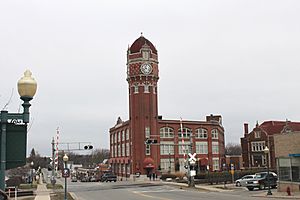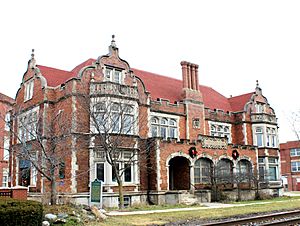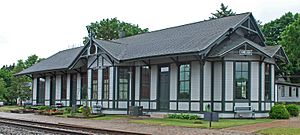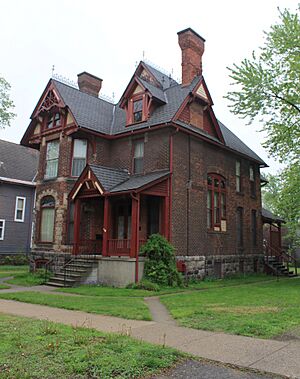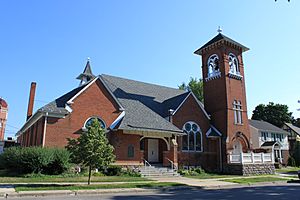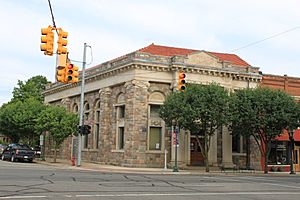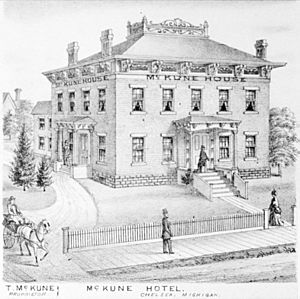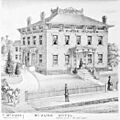Chelsea Commercial Historic District facts for kids
Quick facts for kids |
|
|
Chelsea Commercial Historic District
|
|
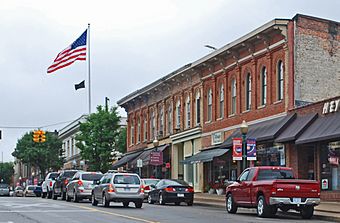
Main Street at W. Middle
|
|
| Location | Main St. and adjacent sections of Middle, Park, Jackson, East, and Orchard Sts., Chelsea, Michigan |
|---|---|
| Built | 1800s |
| NRHP reference No. | 11000046 |
| Added to NRHP | February 22, 2011 |
The Chelsea Commercial Historic District is a special area in Chelsea, Michigan. It includes many old and important buildings along Main Street and nearby streets. This district was added to the National Register of Historic Places in 2011. This means it's recognized as a place with a lot of history and special buildings worth protecting.
Contents
A Look Back: Chelsea's Story
The town of Chelsea began in the 1830s. Two brothers, Elisha and James Congdon, were the first to settle here. In 1848, they gave land to the Michigan Central Railroad to build a train station. This was a big deal!
The first building, a freight station, was finished in 1850. Soon after, the Congdons planned out the village of Chelsea. A blacksmith shop and a hotel were among the first public buildings. The train business helped Chelsea grow quickly in the mid-1800s. More schools, churches, and shops were built.
At first, many buildings were made of wood. But after some big fires in the 1870s, people started building with brick. That's why many of the old buildings you see today are made of brick!
What is the Historic District Like?
The Chelsea Commercial Historic District starts near the old railroad tracks on Main Street. It goes south through most of Chelsea's historic downtown. Most buildings here are shops and businesses. But you'll also find public buildings, churches, and even a few old homes.
Cool Buildings to See
The Chelsea Commercial Historic District has 61 important buildings. These are called "contributing structures" because they add to the district's history. Let's explore some of the most interesting ones!
Glazier Stove Company Warehouse and Clocktower Building
This big building is at 310 North Main Street. It's a very famous landmark in Chelsea because of its tall clocktower. It was recognized as a Michigan State Historic Site in 1997.
The warehouse is three stories tall and made of dark red brick. It was built using a special method with reinforced concrete. The clocktower was originally meant to hold the building's water tower. Today, it's one of the most recognizable sights in Chelsea.
Frank Porter Glazier owned the Glazier Stove Company. He made the company very successful. He hired Caire Allen to design this building. The building is now used for shops and offices.
Welfare Building
The Welfare Building is at 130 North Main Street. It's a brick building that was named a Michigan State Historic Site in 1979.
This building was built in 1906 by Frank P. Glazier. He wanted it to be a fun place for his workers. It had a swimming pool, a billiard hall, a basketball court, a theater, and a reading room! After Glazier's company faced financial trouble, the building was sold. Later, the local newspaper, the Chelsea Standard, moved in.
Michigan Central Railroad Chelsea Depot
The old train station, called the Michigan Central Railroad Chelsea Depot, is at 150 Jackson Street. It's a very special building! It was named a Michigan State Historic Site in 1986 and added to the National Register of Historic Places in 1987.
This station was built in 1880. It has a unique "Stick style" design with many pointed roofs and fancy decorations. Most of the building is covered with horizontal wooden siding. A brick patio surrounds the building. It looks almost exactly as it did when it was first built!
The station served train passengers until 1975. After a few years of being used for storage, a group of Chelsea citizens bought it in 1985. They wanted to save this important building. They started fixing it up in 1986. Today, the depot is rented out for community events and private parties.
Longworth Complex
The Longworth Complex is a group of three connected buildings at Main and Jackson Streets. It includes the Chelsea House Livery Stable, the Daniels Showroom, and the Mack Building.
The Chelsea House Livery Stable is a two-story building at 110 Jackson Street. It was built in 1905-1906. It was a place where travelers could keep their horses when they arrived by train. Later, it became a shop for a car dealership.
The Daniels Showroom was a smaller building next to the Mack Building. It was built in 1947 and had large glass windows. It was used to show off cars. This building was taken down in 2012.
The Mack Building is a two-story building at 102 Jackson Street, built in 1901. After the Daniels Showroom was removed, plans were made to restore the Mack Building's original look.
George W. Palmer House
The George W. Palmer House is a beautiful old home at 138 East Middle Street. It was added to the National Register of Historic Places in 1996.
This two-story brick house is a great example of the "Queen Anne" style. It has a unique L-shape and a fancy roof with gables. The brickwork is very detailed, with different patterns and stone decorations.
The house was built in 1888 for a doctor named George W. Palmer. Later, it became a small private hospital called Chelsea Private Hospital. After the hospital closed, it was used as a place for women working in defense factories to live. It was also an apartment building for many years. In 1991, a family bought it and restored it to be a single-family home again.
First Congregational Church of Chelsea
This church building is at 121 Middle Street. It was recognized as a Michigan State Historic Site in 1995.
It's a well-preserved example of a Romanesque/Italian style building. It's made of red brick with stone details and sits on a stone foundation. The church has a main auditorium and other sections for meetings and offices.
The first church on this spot was built in 1849. It burned down in 1894. The current church was built to replace it and was finished in 1895.
George P. Glazier Memorial Building
The George P. Glazier Memorial Building is a commercial building at 122 South Main Street. It was named a Michigan State Historic Site in 1986.
This two-story building has a unique French Renaissance style. It's made of rough stone with smooth limestone details. It has a special roof covered with red tiles. Large columns decorate the front, and a small porch covers the main entrance.
Frank P. Glazier built this building in 1901-1902 to honor his father, George P. Glazier. It first housed the Chelsea Savings Bank, which his father founded. Today, it's used as an office for the 14th district court.
McKune Memorial Library
The McKune Memorial Library is a public building at 221 South Main Street. It has a long and interesting history!
Elisha Congdon, one of Chelsea's first settlers, built a log house here in 1832. After it burned down, he built a new wooden house. In 1860, he built the brick house you see today.
In 1870, a businessman named Timothy McKune bought the house and turned it into a hotel called the "McKune House Hotel." Later, his son took over. As time went on, it became more of a rooming house.
In the 1940s, a group called the Friends of the Chelsea Library started looking for a home for the library. In 1956, Edward McKune's widow, Katherine, offered to give the McKune house to the library after she passed away. She passed away two years later, in 1958.
The Friends of the Chelsea Library worked hard to fix up the house. The library officially opened in 1959! More parts were added in 1961 and 2004. The front porch was even rebuilt in 1995 to look like the original one.
Images for kids





